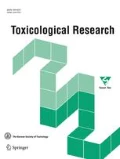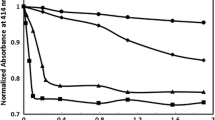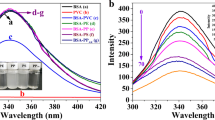Abstract
Vinyl chloride is a colorless gas with a pleasant odor capable of entering the body through oral or inhalation routes. Extensive studies on this compound indicated that it is a carcinogen, and Vinyl chloride exposure can result in a specific type of cancer in vinyl chloride workers. Whereas hemoglobin plays a vital role in oxygen transfer throughout the body, in a molecular aspect, the effect of vinyl chloride on human hemoglobin has not been studied. Furthermore, selenium as an antioxidant is a vital factor for the health of humans and animals. Then this research investigated the effect of the antioxidant capability of selenium at the same concentrations in blood on the interaction between vinyl chloride and hemoglobin. UV–visible, Fourier-transform infrared, chemiluminescence, and fluorescence spectroscopies were employed. The results indicated the destruction of hemoglobin structure in different concentrations of vinyl chloride. At the same time, the antioxidant effect of selenium inhibited the destructive impact of vinyl chloride on hemoglobin structure.









Similar content being viewed by others
Data availability
All relevant data included in this manuscript.
Abbreviations
- VCM:
-
Vinyl chloride monomer
References
Anders LC, Lang AL, Anwar-Mohamed A, Douglas AN, Bushau AM, Falkner KC, Hill BG, Warner NL, Arteel GE, Cave M, McClain CJ (2016) Vinyl chloride metabolites potentiate inflammatory liver injury caused by LPS in mice. Toxicol Sci 151:312–323. https://doi.org/10.1093/toxsci/kfw045
Reitze AW Jr, Lowell R (2000) Control of hazardous air pollution. BC Envtl Aff L Rev 28:229. https://lawdigitalcommons.bc.edu/ealr/vol28/iss2/2
Dogliotti E (2006) Molecular mechanisms of carcinogenesis by vinyl chloride. Ann Ist Super Sanita 42:163
Oehha CA (1999) Chloropicrin acute toxicity summary. Toxicol Lett. https://doi.org/10.1016/j.toxlet.2020.01.022
IARC Working Group on the Evaluation of the Carcinogenic Risk of Chemicals to Humans (1979) IARC monographs on the evaluation of the carcinogenic risk of chemicals to humans. Food Chem Toxicol. https://doi.org/10.1016/0278-6915(84)90103-0
Kielhorn J, Melber C, Wahnschaffe U, Aitio A, Mangelsdorf I (2000) Vinyl chloride: still a cause for concern. Environ Health Perspect 108:579–588. https://doi.org/10.1289/ehp.00108579
Swenberg JA, Lu K, Moeller BC, Gao L, Upton PB, Nakamura J, Starr TB (2011) Endogenous versus exogenous DNA adducts: their role in carcinogenesis, epidemiology, and risk assessment. Toxicol Sci 120:S130-S145. https://doi.org/10.1093/toxsci/kfq371
Anders LC, Yeo H, Kaelin BR, Lang AL, Bushau AM, Douglas AN, Cave M, Arteel GE, McClain CJ, Beier JI (2016) Role of dietary fatty acids in liver injury caused by vinyl chloride metabolites in mice. Toxicol Appl Pharmacol 311:34–41. https://doi.org/10.1016/j.taap.2016.09.026
Wong RH, Chen PC, Du CL, Wang JD, Cheng TJ (2002) An increased standardized mortality ratio for liver cancer among polyvinyl chloride workers in Taiwan. Occup Environ Med 59:405–409. https://doi.org/10.1136/oem.59.6.405
Fedeli U, Girardi P, Mastrangelo G (2019) Occupational exposure to vinyl chloride and liver diseases. World J Gastroenterol 25:4885–4891. https://doi.org/10.3748/wjg.v25.i33.4885
Clewell HJ, Gentry PR, Gearhart JM, Allen BC, Andersen ME (2001) Comparison of cancer risk estimates for vinyl chloride using animal and human data with a PBPK model. Sci Total Environ 274:37–66. https://doi.org/10.1016/s0048-9697(01)00730-6
Nagai M, Mizusawa N, Kitagawa T, Nagatomo S (2018) A role of heme side-chains of human hemoglobin in its function revealed by circular dichroism and resonance Raman spectroscopy. Biophys Rev 10:271–284. https://doi.org/10.1007/s12551-017-0364-5
Perutz MF (1989) Myoglobin and haemoglobin: role of distal residues in reactions with haem ligands. Trends Biochem Sci 14:42–44. https://doi.org/10.1016/0968-0004(89)90039-x
Vuletich DA, Falzone CJ, Lecomte JT (2006) Structural and dynamic repercussions of heme binding and heme-protein cross-linking in Synechococcus sp. pcc 7002 hemoglobin. Biochemistry 45:14075–14084. https://doi.org/10.1021/bi061532g
Liong EC, Dou Y, Scott EE, Olson JS, Phillips GN Jr (2001) Waterproofing the heme pocket: role of proximal amino acid side chains in preventing hemin loss from myoglobin. J Biol Chem 276:9093–9100. https://doi.org/10.1074/jbc.m008593200
Pieczyńska J, Grajeta H (2015) The role of selenium in human conception and pregnancy. J Trace Elem Med Biol 29:31–38. https://doi.org/10.1016/j.jtemb.2014.07.003
Zeng H (2009) Selenium as an essential micronutrient: roles in cell cycle and apoptosis. Molecules 14:1263–1278. https://doi.org/10.3390/molecules14031263
Saha SK, Lee SB, Won J, Choi HY, Kim K, Yang GM, Dayem AA, Cho SG (2017) Correlation between oxidative stress, nutrition, and cancer initiation. Int J Mol Sci 18:1544. https://doi.org/10.3390/ijms18071544
Schwarz K, Foltz CM (1978) Selenium as an integral part of factor 3 against dietary necrotic liver degeneration. Nutr Rev 36:338–340. https://doi.org/10.1111/j.1753-4887.1978.tb03701.x
Hink WF, Briggs JD (1968) Bactericidal factors in haemolymph from normal and immune wax moth larvae, Galleria mellonella. J Insect Physiol 14:1025–1034. https://doi.org/10.1016/0022-1910(68)90011-5
Benesch RE, Benesch R, Yu CI (1969) Oxygenation of hemoglobin in the presence of 2, 3-diphosphoglycerate. Effect of temperature, pH, ionic strength, and hemoglobin concentration. Biochemistry 8:2567–2571. https://doi.org/10.1021/bi00834a046
Antonini E, Brunori M (1970) Hemoglobin. Annu Rev Biochem 39:977–1042. https://doi.org/10.1146/annurev.bi.39.070170.004553
Hao JN, Xu XY, Lian X, Zhang C, Yan B (2017) A luminescent 3d–4f-4d MOF nanoprobe as a diagnosis platform for human occupational exposure to vinyl chloride carcinogen. Inorg Chem 56:11176–11183. https://doi.org/10.1021/acs.inorgchem.7b01549
Brandt-Rauf PW, Li Y, Long C, Monaco R, Kovvali G, Marion MJ (2012) Plastics and carcinogenesis: the example of vinyl chloride. J Carcinog 11:5. https://doi.org/10.4103/1477-3163.93700
Fujiwara R (2018) Exposure to sub-parts per million levels of vinyl chloride can increase the risk of developing liver injury. Hepatol Commun 2:227–229. https://doi.org/10.1002/hep4.1169
Kumar AK, Balachandar V, Arun M, Ahamed SA, Kumar SS, Balamuralikrishnan B, Sankar K, Sasikala K (2013) A comprehensive analysis of plausible genotoxic covariates among workers of a polyvinyl chloride plant exposed to vinyl chloride monomer. Arch Environ Contam Toxicol 64:652–658. https://doi.org/10.1007/s00244-012-9857-1
Ward E, Boffetta P, Andersen A, Colin D, Comba P, Deddens JA, De Santis M, Engholm G, Hagmar L, Langard S, Lundberg I (2001) Update of the follow-up of mortality and cancer incidence among European workers employed in the vinyl chloride industry. Epidemiology 1:710–718. https://doi.org/10.1097/00001648-200111000-00021
Huang PC, Liu LH, Shie RH, Tsai CH, Liang WY, Wang CW, Tsai CH, Chiang HC, Chan CC (2016) Assessment of urinary thiodiglycolic acid exposure in school-aged children in the vicinity of a petrochemical complex in central Taiwan. Environ Res 150:566–572. https://doi.org/10.1016/j.envres.2015.11.027
Emadi M, Maghami P, Khorsandi K, Hosseinzadeh R (2019) Biophysical study on the interaction of cartap hydrochloride and hemoglobin: heme degradation and functional changes of protein. J Biochem Mol Toxicol 33:e22325. https://doi.org/10.1002/jbt.22325
Chakraborty M, Paul S, Mitra I, Bardhan M, Bose M, Saha A, Ganguly T (2018) To reveal the nature of interactions of human hemoglobin with gold nanoparticles having two different morphologies (sphere and star-shaped) by using various spectroscopic techniques. J Photochem Photobiol B Biol 178:355–366. https://doi.org/10.1016/j.jphotobiol.2017.11.026
Minai-Tehrani D, Toofani S, Yazdi F, Minai-Tehrani A, Mollasalehi H, Ziabari KB (2017) Inhibition of pseudoperoxiadse activity of human red blood cell hemoglobin by methocarbamol. Int J Biol Macromol 94:788–792. https://doi.org/10.1016/j.ijbiomac.2016.09.049
Valipour M, Maghami P, Habibi-Rezaei M, Sadeghpour M, Khademian MA, Mosavi K, Ahmad F, Moosavi-Movahedi AA (2017) Counteraction of the deleterious effects of reactive oxygen species on hemoglobin structure and function by ellagic acid. J Lumin 182:1–7. https://doi.org/10.1016/j.jlumin.2016.10.003
Ariaeenejad S, Moosavi-Movahedi A, Kavousi K, Reza Dayer M, Hong J, Yousefi R, Sheibani N, Habibi-Rezaei M (2014) The species and heme pocket properties of Sturgeon Hemoglobins upon interaction with N-dodecyl trimethylammonium bromide. Protein Pept Lett 21:171–178. https://doi.org/10.2174/09298665113209990092
Hosseinzadeh R, Moosavi-Movahedi AA (2016) Human hemoglobin structural and functional alterations and heme degradation upon interaction with benzene: a spectroscopic study. Spectrochim Acta A Mol Biomol Spectrosc 157:41–49. https://doi.org/10.1016/j.saa.2015.12.014
Cary L, Naveau A, Migeot V, Rabouan S, Charlet L, Foray N, Séby F, Bueno M, Jury C, Parmentier M, Louart J (2017) From water-rock interactions to the DNA: a review of selenium issues. Procedia Earth Planet Sci 17:698–701. https://doi.org/10.1016/j.proeps.2016.12.157
El-Demerdash FM, Nasr HM (2014) Antioxidant effect of selenium on lipid peroxidation, hyperlipidemia and biochemical parameters in rats exposed to diazinon. J Trace Elem Med Biol 28:89–93. https://doi.org/10.1016/j.jtemb.2013.10.001
Safhi MM, Alam MF, Khuwaja G, Ashafaq M, Khan A, Islam F, Anwer T, Khan G, Sivakumar SM, Islam F (2018) Selenium in combination with tellurium protects the toxicity of tellurium in the liver mitochondria of rats. Bull Environ Pharmacol Life Sci 7:90–95. https://doi.org/10.1016/j.jsps.2020.04.002
Wrobel JK, Power R, Toborek M (2016) Biological activity of selenium: revisited. IUBMB Life 68:97–105. https://doi.org/10.1002/iub.1466
Hatfield DL, Berry MJ, Gladyshev VN (2011) Selenium: its molecular biology and role in human health. Springer. https://doi.org/10.1007/978-1-4614-1025-6
Zimmerman MT, Bayse CA, Ramoutar RR, Brumaghim JL (2015) Sulfur and selenium antioxidants: challenging radical scavenging mechanisms and developing structure–activity relationships based on metal binding. J Inorg Biochem 145:30–40. https://doi.org/10.1016/j.jinorgbio.2014.12.020
Barth A (2007) Infrared spectroscopy of proteins. Biochem Biophys Acta 1767:1073–1101. https://doi.org/10.1016/j.bbabio.2007.06.004
Calabrò EM, Magazù S (2014) Unfolding-induced in haemoglobin by exposure to electromagnetic fields: an FTIR spectroscopy study. Orient J Chem 30:31–35. https://doi.org/10.13005/ojc/300104
Kim GH, Kim JE, Rhie SJ, Yoon S (2015) The role of oxidative stress in neurodegenerative diseases. Exp Neurobiol 24:325–340. https://doi.org/10.5607/en.2015.24.4.325
Lévy E, El Banna N, Baïlle D, Heneman-Masurel A, Truchet S, Rezaei H, Huang ME, Béringue V, Martin D, Vernis L (2019) Causative links between protein aggregation and oxidative stress: a review. Int J Mol Sci 20:3896. https://doi.org/10.3390/ijms20163896
Uttara B, Singh AV, Zamboni P, Mahajan RT (2009) Oxidative stress and neurodegenerative diseases: a review of upstream and downstream antioxidant therapeutic options. Curr Neuropharmacol 7:65–74. https://doi.org/10.2174/157015909787602823
Acknowledgements
This paper and the research behind it would not have been possible without the exceptional support of my colleges at Zakariaye Razi Laboratory Complex, Science and Research Branch, Islamic Azad University
Funding
This study was unfunded.
Author information
Authors and Affiliations
Contributions
PM: conceptualized and designed the study, collected the data, interpreted and analyzed the data, provided contributions and critically revised the manuscript, and gave final approval of the version to be published. NHO: collected the data, interpreted and analyzed the data, drafted the manuscript and provided contributions and critically revised the manuscript, and gave final approval of the version to be published. MV: interpreted and analyzed the data, critically revised the manuscript, and gave final approval of the version to be published.
Corresponding author
Ethics declarations
Conflict of interest
The authors declare that they have no competing interests.
Ethical approval
The study included searching and reviewing only publicly available information online. There was no need for ethical approval.
Consent to participate
Not applicable.
Consent for publication
All authors agree to publish this manuscript.
Rights and permissions
About this article
Cite this article
Oushani, N.H., Valipour, M. & Maghami, P. Protective role of selenium on structural change of human hemoglobin in the presence of vinyl chloride. Toxicol Res. 38, 557–566 (2022). https://doi.org/10.1007/s43188-022-00137-1
Received:
Revised:
Accepted:
Published:
Issue Date:
DOI: https://doi.org/10.1007/s43188-022-00137-1




